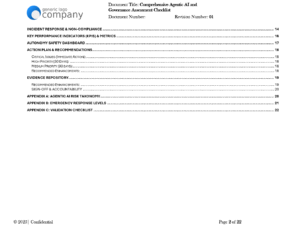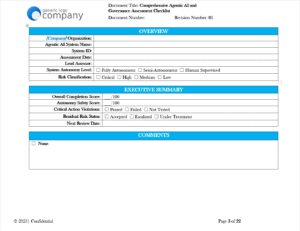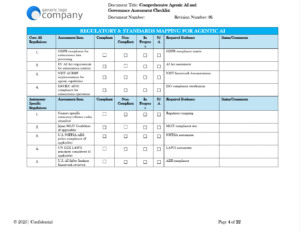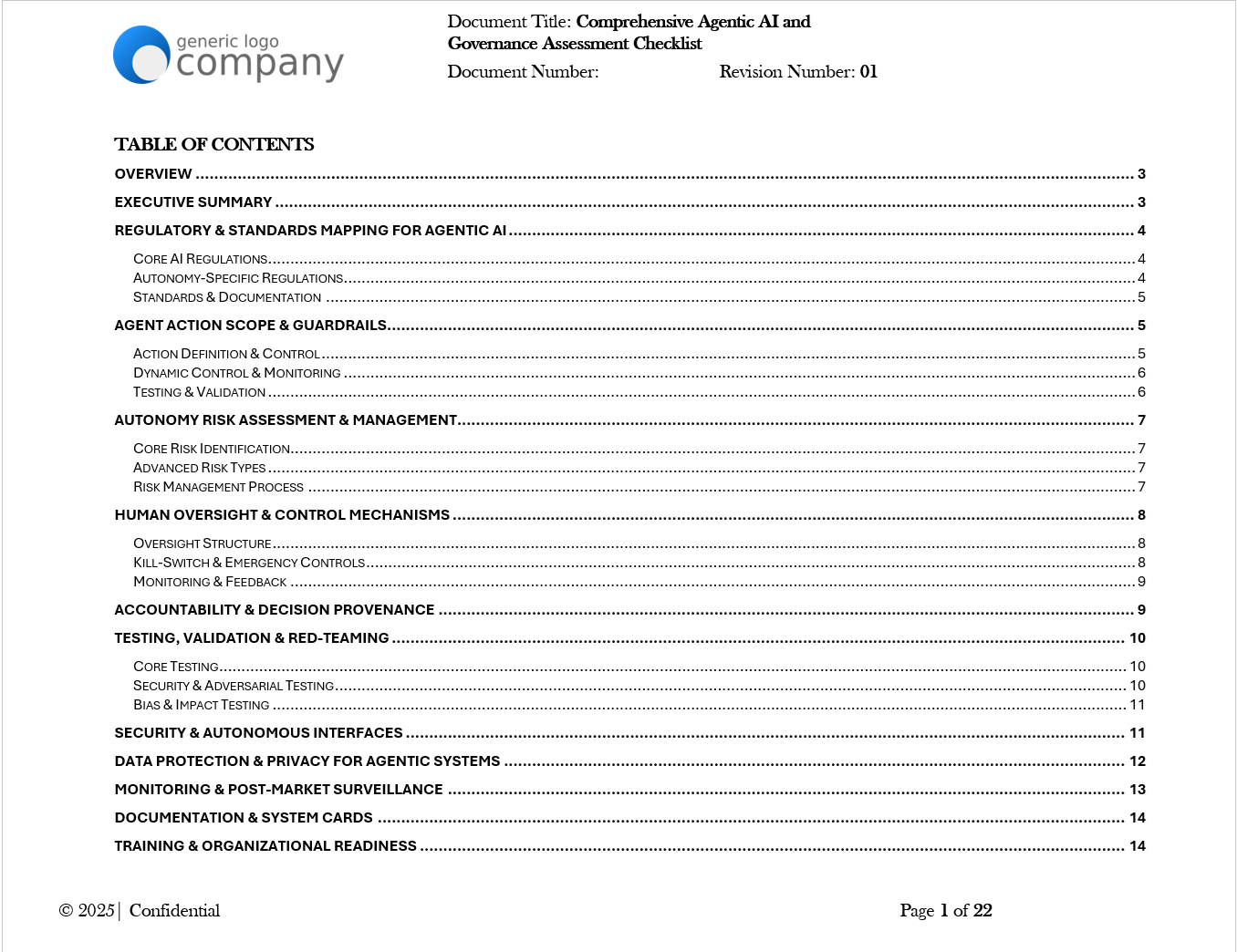
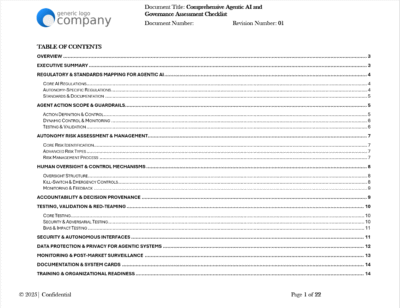
- Version
- Download
- File Size 0.00 KB
- File Count 0
- Create Date August 24, 2025
- Last Updated August 24, 2025
Comprehensive Agentic AI Compliance and Governance Assessment
Subtitle: Assess, document, and govern autonomous AI systems with a compliance-ready Agentic AI Compliance Assessment framework.
Ensure Agentic AI Compliance & Governance: [Download Now]
Autonomous and agentic AI systems require specialized compliance frameworks. The Comprehensive Agentic AI Compliance Assessment Template provides organizations with a governance-grade toolkit to evaluate risks, enforce guardrails, and demonstrate compliance with global standards.
Key Benefits:
-
✅ Agentic AI Focus: Designed specifically for autonomous and semi-autonomous AI systems.
-
✅ Global Framework Alignment: Built on EU AI Act, NIST AI RMF, ISO/IEC 42001, ISO/IEC 38507, and OECD AI Principles.
-
✅ Risk & Oversight: Covers autonomy risks, kill-switches, red-teaming, and decision provenance.
-
✅ Audit-Ready: Evidence repository, accountability sign-offs, and compliance mapping included.
-
✅ Future-Proof: Integrates autonomy-specific regulations (NHTSA ADS, Japan MLIT, UN GGE LAWS, US AI Safety Institute).
Who Uses This?
CIOs, CAIOs, compliance officers, risk managers, and audit teams responsible for Agentic AI Compliance Assessment in high-risk, mission-critical environments.
Why This Matters
Agentic AI introduces new governance challenges beyond traditional machine learning — including dynamic action control, autonomy guardrails, and kill-switch oversight. Regulators are quickly addressing autonomy-specific risks through the EU AI Act, U.S. AI Safety Institute, NHTSA ADS policy, and ISO/IEC 42001. This Agentic AI Compliance Assessment template equips organizations with a comprehensive framework to evaluate, monitor, and govern agentic AI systems.
Framework Alignment
The Comprehensive Agentic AI Compliance Assessment maps to:
-
EU AI Act — Risk classification and obligations for autonomous systems.
-
NIST AI RMF — Risk management lifecycle with autonomy controls.
-
ISO/IEC 42001 & 23894 — AI governance and risk standards for autonomy.
-
ISO/IEC 38507 — Decision provenance and oversight for agentic AI.
-
OECD AI Principles — Accountability, transparency, and human oversight.
-
Sectoral Guidelines — NHTSA ADS, Japan MLIT, UN GGE LAWS, U.S. AI Safety Institute.
Key Features
-
Regulatory & Standards Mapping: EU AI Act, GDPR, ISO/IEC 42001, NIST AI RMF, and autonomy-specific standards.
-
Action Scope & Guardrails: Defines allowed, restricted, and safe actions for agentic AI.
-
Dynamic Control & Monitoring: Detects scope drift, privilege escalation, and self-modification.
-
Testing & Validation: Red-teaming, adversarial testing, sandbox environments, and validation logs.
-
Risk Management: Core and advanced risk identification, residual risk scoring, and executive summaries.
-
Human Oversight: Governance committees, accountability chains, and kill-switch protocols.
-
Transparency & Documentation: System cards, provenance tracking, evidence repository.
-
Incident Response: Escalation, emergency controls, and non-compliance workflows.
-
KPIs & Dashboards: Autonomy safety scorecards and monitoring dashboards.
Comparison Table
| Feature | Generic AI Checklist | Agentic AI Compliance Assessment (Pro) |
|---|---|---|
| Autonomy-specific governance | Not covered | Dedicated to agentic & autonomous AI |
| Framework coverage | Limited | EU AI Act, NIST AI RMF, ISO/IEC 42001, ISO/IEC 38507 |
| Action scope & guardrails | Absent | Whitelist/blacklist, kill-switch, drift detection |
| Oversight & accountability | Minimal | RACI roles, sign-offs, provenance systems |
| Red-teaming & validation | General testing | Adversarial, bias, and autonomy interface testing |
| Audit-readiness | Weak | Evidence repository, autonomy dashboard, version history |
FAQ Section
Q1: What is Agentic AI Compliance Assessment?
A: Agentic AI Compliance Assessment is a structured evaluation of governance, risk, and safety requirements for autonomous and semi-autonomous AI systems.
Q2: Which regulations does this assessment support?
A: It aligns with EU AI Act, NIST AI RMF, ISO/IEC 42001, ISO/IEC 38507, GDPR, and OECD AI Principles, plus sector-specific standards (NHTSA, MLIT, UN GGE LAWS).
Q3: Does it cover technical guardrails?
A: Yes. It includes action whitelists, restricted actions, kill-switch protocols, and dynamic monitoring controls.
Q4: Is it suitable for SMEs as well as enterprises?
A: Yes. SMEs can adapt the core compliance sections, while enterprises can apply full oversight, dashboards, and evidence repositories.
Q5: Does it include testing and red-teaming requirements?
A: Yes. It includes sandbox testing, adversarial simulations, bias/impact validation, and autonomy interface security reviews.
Q6: What format is best for viewing these templates?
A: Documents are best viewed and used via Microsoft Word or Microsoft Excel. Formatting may not fully display in Google Docs or other editors.
Ideal For
-
AI Governance & Compliance Committees
-
Chief AI Officers (CAIOs)
-
Risk & Audit Teams
-
AI Safety & Assurance Functions
-
Legal & Policy Leaders overseeing autonomous systems
-
Vendor/Third-Party AI Risk Management


